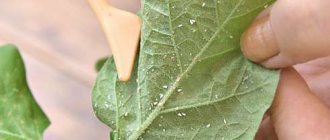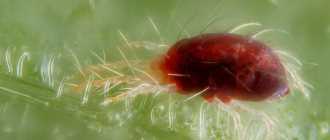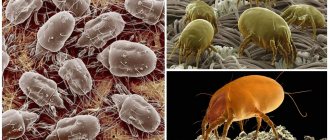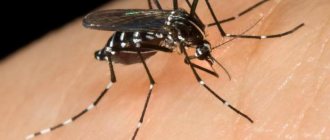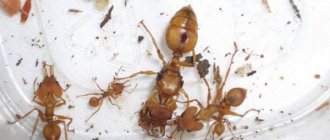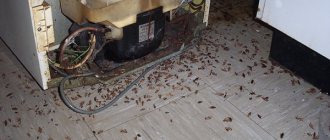Description of the spider mite
Despite their miniature size, spider mites are not insects. They belong to the Arachnids and are distant relatives of scorpions and spiders. They are distinguished from insects by a larger number of limbs. Some species of Arachnids are so tenacious that they can exist even in the harsh northern climate.
The body of the spider mite is oval in shape and does not exceed 0.5 mm in length. The color of the chitinous cover is largely determined by the food consumed. Most often it is green or reddish. Although the parasite has 4 pairs of legs, it moves very slowly. During their life, mites weave a very thin web, entangling all parts of the indoor orchid with it. All stages of tick development from egg laying to adulthood pass under its protection.
Spider mites reproduce very quickly. From the moment the female lays eggs until the appearance of a sexually mature individual, 10 to 20 days pass. At the same time, the duration of development is influenced by the climate of the region. The hatched larvae initially have only 3 pairs of legs. Only after a few molts do they develop a fourth pair of legs. In total, spider mites live about 40 days.
For normal life and reproduction, this pest requires a temperature of +27 degrees. In this case, the humidity in the room should be from 30 to 40%. At higher humidity, the development of parasites slows down.
Types of spider mites:
It may be interesting Why the roots of the phalaenopsis orchid rot and what to doDescription and features of the Dendrobium Nobile orchidGarlic water for orchids: how to prepare and use correctly
- The root mite has an elongated oval body with 6 legs. It adapts perfectly to harsh external conditions and can survive for several months without food. Most often it affects the root system of plants.
- Red spider mites are more widespread than others. Their body is bright orange or yellow. They adapt well to the action of toxic substances.
- Bulb mites are the slowest. Their body length is no more than 0.5 mm. They have a dark brown color and short bristles on the body.
- Oribatid mites look like spiders. They use plant roots for nutrition.
- The Phalaenopsis flat mite is very small. Its length is no more than 0.3 mm. On the back of its belly there are two bristles in the form of antennae. Usually hides in hidden places on the plant.
- The greenhouse beetle has a terracotta-red ovoid body with a net-like pattern. At all stages of life, this arachnid is colored in different shades of red. Therefore, it is often called the red flat mite.
- The oncidium flat mite has an orange-red oval body up to 0.3 mm long. It damages leaves and infects plant tissue with its toxic saliva.
Disease prevention
To prevent mites from appearing on orchids, the following preventive measures must be observed:
- Periodically dry the soil in which the flower grows.
- Spray the flower in a timely manner and ensure that drops of liquid do not stagnate in the axils of the leaves. Otherwise, the orchid will rot.
- Maintain the optimal watering regime.
- Ticks appear in rooms with dry air. You can increase the humidity by placing a container of water at room temperature near the orchid for 2 days. The water will evaporate and the air will become humidified.
Caring for an orchid is very difficult, especially when it comes to pest control. The difficulty is that the flower is attacked by small parasites such as mites. It is not always possible to see them immediately and eliminate them in a timely manner, so you have to resort to more aggressive methods of control when the accumulation of pests is already massive.
If you find an error, please select a piece of text and press Ctrl+Enter.
Experienced farmers know well that the appearance of mites on an orchid is a very common occurrence. There can be many reasons for this - improper care of the plant, changes in temperature and humidity, and lack of fertilizing. To get rid of a dangerous pest, you should know and be able to use certain methods and technologies.
Harm caused
These parasites use plant sap as a source of nutrients. When biting a leaf plate or stem, it releases a special secretion into the tissues, which destroys the cellular structure of the plant. This activates the juice separation. Air enters through the puncture. In the damaged area, a light coating first forms, then the surface becomes covered with cobwebs. Over time, the leaf turns yellow, dries out and falls off.
When there is a large colony of mites, cobwebs appear not only on the leaves, but also on the flowers. Then the foliage turns yellow, curls and falls off very quickly. The same thing happens with buds. They also dry out and crumble. If the plant is heavily infested with spider mites, it may die.
Important!
Another danger of spider mites is the increased risk of developing viral and fungal diseases. Therefore, often, along with signs of the presence of spider mites, dark or weeping spots are noticeable on the plant.
Conditions of appearance and signs of damage
On phalaenopsis, root mites will multiply quickly when:
- dry air;
- high temperature;
- provided that the plant has a weakened immune system.
Experts have found that the spider feels comfortable when:
- temperature +28+32C;
- humidity less than 50%.
Flat-bodied ticks can develop in closed ground throughout the year, and they do not require special conditions. High humidity can only slow down the transformation of a small individual into an adult, but this process is inevitable.
Important!
To prevent the plant from becoming infected with pests, it is prohibited to use contaminated planting substrate taken from the garden bed. Even if there is a need to use such soil, it must be prepared and processed.
Mites on an orchid are located to feed on the juices of the flower. This occurs by piercing the surface of the foliage or stems, through which the pest introduces a substance that can destroy the cell membrane. This helps to accelerate the secretion of juice and its release through the affected area, through which the spider feeds.
Through the hole made, air penetrates into the structure, and this leads to the transformation of green foliage into silver, it becomes covered with cobwebs. Soon the leaves will turn yellow, and the affected areas will quickly spread throughout the plant, causing them to fall off.
In some cases, cobwebs can be found not only on the foliage, but also on the surface of the buds. This is a sign of the presence of a large spider colonization, and if the orchid is not treated for mites, it will die. What will happen:
- gradual yellowing;
- curling the tips of the leaves;
- drying out;
- death of leaves and buds.
If the orchid is not treated, mites can cause a bacterial, viral or fungal disease, as evidenced by the presence of dark spots and weeping areas.
Symptoms of mite damage to orchids
Insect control measures should be chosen depending on the signs of the presence of a spider. It is too difficult for inexperienced gardeners to detect arthropods, especially without using optical instruments. Education can be considered a characteristic feature:
- Cobwebs are silvery or white on the underside of the leaves, which, when pressed, acquire a reddish tint and transform into a liquid substance.
- Small white spots on the surface of the leaf blade, which look like many injections made with a thin needle, which leads to the death of the affected tissue.
Note.
Over time, the dots merge into brown spots, which is why the green areas die off. Injections can be seen in the area of the leaf axil; you need to regularly inspect the plant.
How to inspect a plant
The fight against spider mites on orchids begins with a thorough examination of the flower to detect parasites. They look different, and therefore it is worth studying all their forms. Since it is almost impossible to examine the spider, you need to pay attention to the following points:
- accumulation of insects on the back of the foliage;
- sudden decline for no reason;
- formation of large and white spots;
- white cobwebs throughout the plant;
- twisted and dried leaves.
Do not confuse black and white spots, as the former are a sign of fungus and mold. Having eliminated the fungus, you should not assume that the problem is solved, since the immune system is weakened and the colonies will begin to actively grow further. Parasites prefer young and succulent foliage, and therefore it is young plants that die.
How to detect mites on an orchid
Due to the very small size of the parasites, they are very difficult to detect on the plant without special optical instruments. Often the appearance of a spider mite on an orchid can be suspected by the thin silvery cobweb that appears on the back of the leaves. Ticks lay their eggs under it. They can be detected by the red liquid that is released when the web is pressed with a flat object.
Detecting flatfishes is even more difficult. Their presence becomes obvious when the infection becomes widespread. If you look closely at the leaves, you will notice tiny white spots on the back of the leaves. In these places, leaf tissue dies off after punctures by pests.
After a few days, these dots enlarge and form large spots. The leaf turns brown, dries out and falls off. Such damaged areas are found in the axils of the leaves, at the base of the stem and in other places. To detect the parasite in time, you need to carefully inspect the plant regularly.
Reasons for appearance
Infection of plants with spider mites often occurs after the acquisition and placement of new indoor crops in the apartment. Even if the flower growers exchanged some exotic flowers among themselves. Infection is sometimes facilitated by damaged soil used for planting.
Insects are able to enter the home due to the wind and can be carried on clothing. Pests can appear due to high air temperature (which results in dry air), low humidity, and the application of fertilizing in excessive quantities.
Sometimes accidental infection with this type of pest occurs. Insects infect the base of the stem or axils of flowers. They also live on the windowsill, window or walls of the flowerpot. Later they move to the phalaenopsis itself. When the window is open, parasites can enter the crop from the foliage of trees.
Causes of infection
Spider mites move with air currents. The wind carries the parasite larvae several kilometers. Hot, windy weather is especially favorable for tick infection. With additional low humidity from 28 to 42%, parasites multiply rapidly. If humidity increases, mites develop more slowly.
Typically, orchid pests enter an apartment in several ways:
- together with contaminated soil;
- with a new plant, purchased in a store or brought from a greenhouse;
- through an open window along with gusts of wind;
- along with a person’s clothing if he was standing near an infected plant.
Where do they come from?
This situation often occurs. The orchid felt great for a long time, when suddenly ticks appeared out of nowhere. There may be several reasons for infection:
- Microscopic arthropods fall onto plants with the wind from an open window. This is one of the reasons why it is better to place orchids away from drafts.
- If a new plant appears in the house, it may be infested with mites. To prevent the spread of pests, the newly acquired indoor flower is placed in quarantine, that is, completely separately. It is monitored for at least two weeks, and only after this period, if no suspicious symptoms are found, is it added to the main collection. The recommendation applies not only to purchased plants, but also to those that you exchange with home gardening enthusiasts.
Mites may appear along with the new plant.
The source of pests can be a substrate with mite larvae. Under favorable conditions - low humidity, dry air, excessive feeding - mites actively develop and spread.
Whatever the reason for the appearance, treatment of an infected orchid is carried out using acaricides.
Fighting spider mites on orchids
To get rid of parasites on phalaenopsis, you need to change the conditions under which the plant is kept. To begin with, the affected areas are treated with a solution of laundry soap. The dry piece is grated with a grater, turning it into shavings. Then 1 tbsp. l. stir with a heap of soap in a liter of warm water. Use a sponge or soft rag to wipe all surfaces of the green part of the plant.
Important!
When processing, try to prevent the solution from getting on the substrate. Soap has a bad effect on orchid roots. The tray and pot are wiped with a disinfectant solution. Additionally, treat the surface on which the pot stands.
Then, to cure the disease, the soil is generously watered with warm water and the plant and pot are placed in a plastic bag. The flower is left in this form for three days. Under cover, humidity increases and parasite activity is suppressed. In this way you can fight ticks. During the entire treatment, the flower is kept in the shade so that the sun's rays do not leave burns on the leaves.
How to deal with them?
To get rid of spider mites and other types of mites at home, you should take a number of effective measures. First of all, it is necessary to disinfect the affected area. You should use diluted laundry soap: one large spoon of liquid soap is mixed in one liter of water. Using a cloth or sponge, gently wipe the surface of the plant.
It is important that the soap solution does not get on the ground, otherwise the root system will be damaged. The tray and pot should be wiped with a disinfectant solution, and if the orchid is on the windowsill, then it is also advisable to wipe all the surfaces around with a soap solution.
After this, you should pour the substrate, cover the plant with a transparent film, and keep it in this form for at least 70 hours. The film increases the percentage of humidity, which promotes the active annihilation of insects and can cure the plant. It is important to remember that the orchid is afraid of direct sunlight; the flower should be kept in the shade.
Chemicals
The most effective drugs in the fight against ticks can be acaricides:
- "Aktofit";
- "Fitoverm";
- "Vertimek".
Special chemicals are often used against spider mites:
- "Aktellik";
- thiophos.
It is recommended to treat the plant with chemicals and at the same time create comfortable greenhouse conditions for it by covering it with a transparent film. The treatment should be done with one of the preparations, and only then use the film. It is also important to remember that ticks are resistant parasites and are able to quickly produce an antidote. From time to time you will have to alternate chemical compositions.
The most dangerous mite is considered to be the root mite. If signs of infection appear, then urgently:
- all affected areas are cut off;
- cut areas are treated with potassium permanganate with the addition of activated carbon;
- diseased flowers are taken to another room;
- soil from pots is recycled;
- pots are wiped with a disinfectant.
The most effective compositions are:
- "Fitoverm";
- "Aktellik";
- "Apollo".
It is best to alternate these substances with the following drugs:
- "Omite";
- "Kleschevit";
- "Vertimek";
- "Dursban";
- "Borneo";
- "Sunmite";
- "Oberon".
Each drug has its own advantages and disadvantages, much depends on the severity of the damage to the plant. If the process is at the very beginning, then a chemical composition such as Apollo will be sufficient. It helps remove small colonies of mites that have just begun to form.
Fitoverm
Fitoverm is a natural insecticide that has proven itself well in the fight against such a parasite as spider mites. The drug has a fairly wide spectrum of action and, importantly, decomposes very quickly both in the air and on the surface of the substrate.
Fitoverm helps fight various pests well.
Fitoverm is based on soil fungi (soil microorganisms). Therefore he:
- Environmentally friendly;
- And it is highly effective not only against various types of ticks, but also against other pests.
, Fitoverm can be classified as an insectoacaricide, since the main active ingredient is the biologically active aversecticin C. Having a paralytic effect on the nervous system, when the parasite gets on the skin or intestines after processing the foliage, it causes paralysis of ticks and then their death.
Mite eggs are very resistant to the drug, so the plant needs to be treated 3-5 times until adults emerge from them . In this case, the next treatment must be carried out no later than 7 days later. The most effective method is to immerse the entire plant in the prepared solution.
If after a couple of treatments the parasites do not die, then it is necessary to change the drug, as a result of the insects developing immunity to it.
Aktellik
An organophosphorus compound with the active ingredient pirimiphos-methyl. It is an intestinal contact poison , in equivalent proportions.
Due to its good sublimation properties, it has excellent penetrating ability, but rather in a small temperature range. Therefore, the effectiveness of the drug is achieved in the intervals between +15° to 25° C.
According to experienced orchid growers, Actellik can confidently be called “Ambulance” for orchids. It not only destroys spider mites, but also many other parasitic insects.
Important! Actellik is a highly toxic drug with hazard class 2. It is not recommended to use it indoors. It is better to carry out processing outdoors.
Actellik is used strictly according to the attached instructions, with re-treatment after 7-10 days, due to inaction on eggs and faces. The destructive effect is noticeable after 7-14 days. Insects have average habituation. It is advisable to periodically change the active ingredients.
Neoron
Probably one of the best and most effective drugs against spider mites. The active ingredient is bromopropylate. Neoron is a specific contact acaricide .
Advantages:
- High initial effect;
- Long lasting;
- High activity in suppressing sensitive and resistant strains of ticks;
- The drug does not penetrate plant tissue;
Neoron has many advantages and positive reviews from customers. - Safe for beneficial insects and bees;
- Ambient temperature has no effect on efficiency;
- Wide range of applications;
- Reduces the number of treatments;
- Economically beneficial.
The duration of the protective effect reaches 40 days, while the destruction of pests occurs almost instantly . Treatment is carried out by spraying. With a small group of parasites, the concentration of the drug can be reduced without loss of effectiveness. Due to the impact on most eggs and larvae, repeated treatment will crown the complete destruction of the pest.
It does not cause addiction to parasites, as it destroys them within a few hours .
Thiophos
Organophosphorus compound, with active ingredients :
- Parathion;
- NIUIF-100.
Tetrix contains metaphos, the methyl form of thiophos.
An oily liquid of a dark brown color with a specific odor reminiscent of garlic.
It is used quite rarely and mainly on an industrial scale in case of massive damage to plants by parasitic insects. A very toxic substance with a high hazard class. It is not recommended to use it at home.
Traditional methods
Traditional methods are effective only in the initial stages of plant disease. A solution of laundry soap is the most common way to treat affected areas of orchids.
A decoction of cyclamen also works well, as it can eliminate colonies of parasites without leaving a trace. To prepare such a composition you should:
- take a tuber of the plant, chop it finely;
- put the pieces in boiling water and boil for 30 minutes;
- Cover the broth with a lid and leave for a day.
This decoction can be used to treat plants for a week.
You can also use medical alcohol against mites, but it is recommended to remember that only adult plants can be coated with it.
A decoction of nettles will help activate plant immunity. It is done like this:
- 750 grams of fresh nettle are poured with three liters of boiling water;
- the resulting mixture is infused for 40 minutes.
When the broth has cooled, the orchid is immersed in it for 5-6 minutes.
The oribatid mite is considered no less harmful; it is extremely voracious and in a few days can gnaw at a plant so that it will inevitably die. In this case, the orchid is removed from the soil along with the root system and soaked in water for 20 minutes. Then the plant is removed and placed on a cotton cloth, the roots should dry. It is recommended to do a similar procedure at least three times, after which the plant is installed in the renewed soil.
It is also important to ensure that drops of water do not collect in the buds and leaves, otherwise these areas may begin to rot.
No chemicals used
How to get rid of an annoying pest? The use of folk remedies is effective for small or few infestations of orchids by spider mites. But first, leaf surfaces and other areas of damage should be wiped with a solution of laundry soap to remove the bulk of the individuals and their eggs.
Recommendation! Soap solution prepared at the rate of 1 tbsp. spoon for 1 liter. water, not only the orchid itself is processed, but also the flower pot and tray for it.
Cyclamen decoction
works well in the fight against this parasite :
- Tubers are taken;
- Cut into several parts;
- And boil for 30-40 minutes;
- Then the product is infused for a day at room temperature;
- And it is used to treat the plant.
The spraying procedure should be carried out several times , every 5 days.
Medical alcohol
Experienced flower growers leave good reviews on the effect of medical alcohol . However, its use is not suitable for all orchids. It is safe to use only for orchids with hard leaves.
First, you should test the effect of alcohol on one sheet. The weak structure of the leaf plate may be subject to burns from high-degree substances. If no burn occurs, then carefully wipe all the leaves of the plant with a cotton swab dipped in alcohol.
How to save a blooming orchid from spider mites
The damage caused to a flowering epiphyte depends directly on how quickly the problem is discovered. If mites were noticed at an early stage of spread, they can be managed by wiping the plant with a soapy solution or washing it in a hot shower.
If the initial stage of disease development is missed, treatment is carried out with chemicals. Then all the buds will inevitably die. It is fortunate if the infection occurred at the final stage of flowering. Otherwise, you have to stop this period at the very beginning.
If a white cobweb is found on a blooming orchid, the following work is carried out to save the flower:
- The diseased flower is transferred to a separate room away from other plants.
- All damaged flowers, buds, leaves and bulbs are cut off.
- The leaf axils and trunk are cleaned of parasites with tweezers.
- Young shoots are not completely cut off. They are cleaned of parasites from above and damaged parts are removed.
- The root system is freed from the substrate and rotten or dried areas are removed.
- The plant is completely washed with a solution of laundry soap and then treated with insecticides.
- Dry the orchid thoroughly and replant it in a dried substrate.
How to get rid of cobwebs
The mass spread of the pest can be recognized by the cobwebs that appear on the flowers. But sometimes it is difficult to notice, since spider mites weave white webs. The first measures to be taken when it is detected:
- Isolate the flower from other house plants.
- All damaged leaves and buds are cut off and the bulb is removed.
- The roots are cleared of soil and carefully examined. All rotten, dry and damaged parts are cut off.
- All parts of the plant are washed with a solution based on laundry soap, then treated with an insecticide.
- When the orchid dries, transplant it into new soil.
Important! Most of all, ticks like to attack young shoots. Since these parts of the plant contain the bulk of the nutrients, they cannot be completely cut off. Therefore, the shoots are partially cut off or treated with an insecticide.
Prevention
To prevent spider mite infection, it is important to maintain conditions that are unfavorable for its life. To do this, regularly spray the plants with water and maintain a high level of humidity in the room.
Another treatment method is bathing in water. To do this, place the orchid and the pot in warm water so that it covers the plant and leave for 3 minutes. All pests present on the flower will come out during that time and remain in the water.
Important!
You can bathe once a month. Otherwise, the risk of root rot increases.
Also, to reduce the likelihood of spider mites, the flower is sprayed every month with a solution of biological preparations in a small concentration. The temperature in the room with the orchid is maintained at the same level, and fallen leaves are immediately removed.
Orchid blooming during spider mite infestation
Spider mites are not so selective about the phases of plant development. Infection of an orchid can occur at any stage of growth, the flowering period is no exception.
Is it possible to carry out processing at this time, because you always want to preserve the gorgeous flowers and buds on the peduncles. It is not only possible, but also necessary, as quickly and actively as possible.
After all, detecting a spider mite infestation at an early stage makes it possible to carry out treatment in a timely manner and prevent the pest from spreading throughout the plant.
There is no need to wait for the end of flowering, because it can last more than six months, and during this time the flower will suffer irreparable damage.
Patience and constant monitoring of the orchid’s condition will help cure the pest invasion.
Folk remedies for pest control
Folk remedies help correct the situation, but only when the problem only makes itself felt. Today, some of the most popular are: treatment with medical alcohol and a decoction of cyclamen tubers.
In order to prepare a decoction of tubers, they must be divided into small parts and boiled for forty minutes. Afterwards you will need to wait a day and strain the tincture. Spraying with the decoction is carried out several times with a break of 4-5 days.
As for treatment with an alcohol solution, it is carried out with extreme caution. To begin with, liquid is poured onto a swab, a small area of the leaf plate is wiped, and then, if nothing happens to the leaves, the entire plant is treated in this way.
